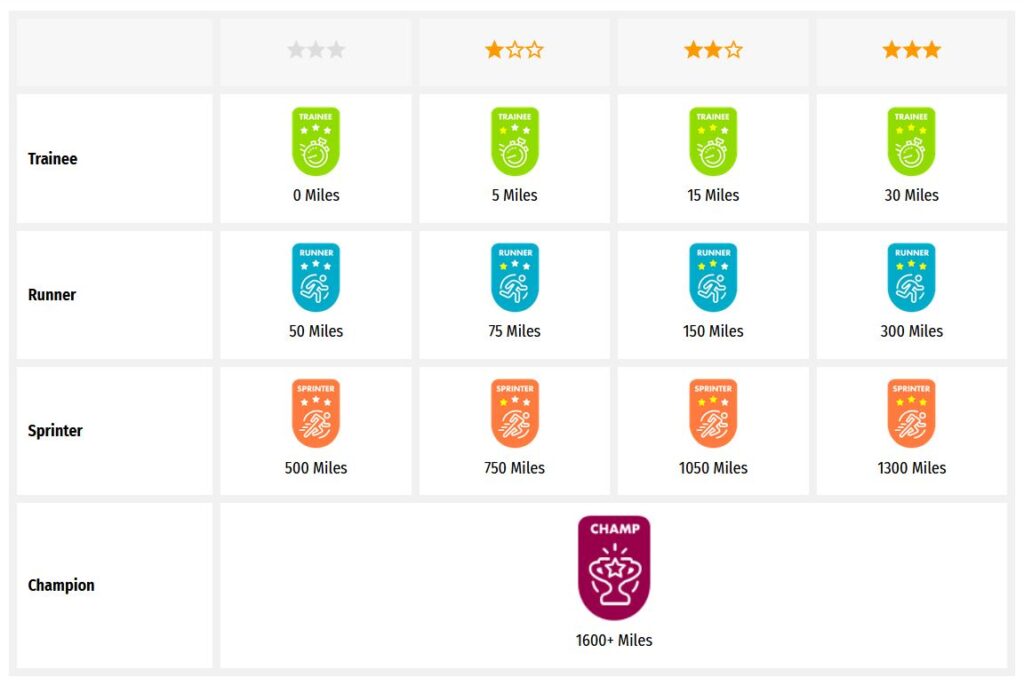Someone else is currently editing this document
Only one person can work on a document at a time
Auszeichnungen von Alwin Metz Item 7
TRANSCRIPTION
Besitz-Urkunde
Dem Kriegsfreiwilligen Herrn Alwin Metz
ist in dankender Anerkennung seiner dem Vaterlande während des Weltkrieges
geleisteten Dienste die von der Gemeinde Oppurg gestiftete
Denkmünze
verliehen worden, was hiermit bezeugt:
Oppurg, den 12. März 1921
Im Namen der Gemeinde:
G. Haase.
Links unten ovaler schwarzer Stempel:
GEMEINDE
ZU
OPPURG
Language(s) of Transcription
LOCATION
Oppurg (50.7001, 11.6497)
Story Location
ABOUT THIS DOCUMENT
Document Date
Document Type
Document Description
Language of Description
Keywords
External Web Resources
People
STORY INFORMATION
Title
Auszeichnungen von Alwin Metz
Source
UGC
Contributor
europeana19141918:agent/c3084ff3f75e957c9583f99dee61d594
Date
1921-03-12
1921-12-01
Type
Story
Language
deu
Deutsch
Country
Europe
DataProvider
Europeana 1914-1918
Provider
Europeana 1914-1918
Rights
http://creativecommons.org/publicdomain/zero/1.0/ http://creativecommons.org/licenses/by-sa/3.0/DatasetName
2020601_Ag_ErsterWeltkrieg_EU
Begin
1921-03-12
End
1921-12-01
Language
mul
Agent
Alwin Metz | europeana19141918:agent/afb33e3756028bc2ef373a0e2f31f609
Reinhart Metz | europeana19141918:agent/c3084ff3f75e957c9583f99dee61d594
Created
2019-09-11T08:48:01.819Z
2019-09-11T08:48:01.792Z
2014-10-08 16:20:52 UTC
Provenance
BE30
Story Description
Auszeichnungen, Besitzzeugnisse und Soldatenmarke von Alwin Metz: ********************************************************************************** (1) Besitzzeugnis für das Verwundetenabzeichen in schwarz ********************************************************************************** (2) Soldatenmarke von Alwin Metz ********************************************************************************** (3) Besitzzeugnis für die Kriegsdenkmünze 1914/18 des Kyffhäuser-Bundes, 1. Dezember 1921 ********************************************************************************** (4) Schreiben über die Übersendung des Eisernen Kreuzes II. Klasse nebst Besitzzeugnis, 17. Juni 1921 ********************************************************************************** (5) Besitzzeugnis Eisernes Kreuz II. Klasse, 17. Juni 1921 ********************************************************************************** (6) Besitz-Urkunde für die Denkmünze der Gemeinde Oppurg, 12. März 1921 **********************************************************************************Der spätere Lehrer Alwin Metz, geb. am 2. Januar 1896 in Oppurg, Thüringen, absolvierte vom 7. Januar 1914 bis zum 1. Oktober 1914 seine Reservistenausbildung an verschiedenen Orten. Als Kriegsfreiwilliger meldete er sich 1914 zum Heeresdienst. Er diente im 9. Bataillon des 224. Reserve-Infanterie-Regiments und war zunächst bis zum 18.12.1914 an der Westfront in Frankreich im Einsatz. Im November/Dezember 1914 wurde er in die Karpaten verlegt. Bei einem Gefecht gegen russische Soldaten in der Nacht zum 1. Februar 1915 erlitt er einen Unterleibsdurchschuss und wurde bei Tuchla gefangen genommen. Sein Lazarett befand sich in Stryj, in der Nähe von Lemberg. Metz wurde nach seinem Aufenthalt im Lazarett in Stryj über Brody, Kiew und die Krim nach Moskau gebracht (März 1915). Ab November 1915 war er in Blagoweschtschensk am Amur (Благове́щенск) interniert, nahe der chinesischen Grenze. Aus seinen Aufzeichnungen gehen weitere Zwischenstationen in Petropawlosk, Omsk, Tobolsk, Tjumen und Nowo Nikolajewsk hervor (August bis November 1915). Als Metz nach Blagoweschtschensk verlegt wurde, war er Leiter der Lagerbibliothek (Bücherwart und Inventarverwalter) und gründete auch einen Chor oder eine Laienspielgruppe. Metz war maßgeblich an der Gestaltung des Lagerlebens beteiligt und an der Freizeitgestaltung der Mitgefangenen. Spätestens ab Mai 1919 befand sich Alwin Metz in dem Kriegsgefangenenlager in Zairkutny-Gorodok bei Irkutsk. Alwin Metz wurde während seines Rückwegs in die Heimat mehrfach zurückgeschickt. Wahrscheinlich war es nicht der offizielle Rücktransport, sondern eine Flucht aus dem Lager, bei der er wieder gefangen genommen und ins Lager zurückgeschickt wurde. 1920 verließ Alwin Metz endgültig das Lager und kehrte am 2. Juli 1920 nach Hause zurück. Vier Tage später, am 6. Juli 1920, entließ man ihn offiziell aus der Armee. Während seiner Rückkehr aus der Gefangenschaft, vom 4. Juni bis zum 2. Juli 1920, auf dem Weg von Sibirien nach Thüringen zurück, führte er ein Tagebuch, dass er in alter Gabelsberger Stenografie verfasste. Zurück in der Heimat unterhielt Alwin Metz in Briefen Kontakt zu ehemaligen Mitgefangenen. Ihm wurde nachträglich am 1. Dezember 1921 vom Weimarischen Krieger- und Vereinsbundes die Kriegsdenkmünze 1914/18 des Kyffhäuser-Bundes sowie im Juni 1921 das Eiserne Kreuz II. Klasse verliehen. Metz hielt zahlreiche Vorträge über seine Kriegsgefangenenzeit in Sibirien vor interessierten Bürgern und Einwohnern in Oppurg und in Neustadt und als Lehrer vor Schülern. Er war bei verschiedenen Vereinen aktiv (Imker, Geflügelzüchter, Kaninchenzüchter). Alwin Metz zog als kriegsbegeisterter Soldat in den Krieg, um gegen die Russen als Feinde zu kämpfen und kehrte nach über fünf Jahren in Gefangenschaft als Freund der Russen zurück.
TRANSCRIPTION
LOCATION
DESCRIPTION
PEOPLE
STORY INFO
TUTORIAL
Besitz-Urkunde
Dem Kriegsfreiwilligen Herrn Alwin Metz
ist in dankender Anerkennung seiner dem Vaterlande während des Weltkrieges
geleisteten Dienste die von der Gemeinde Oppurg gestiftete
Denkmünze
verliehen worden, was hiermit bezeugt:
Oppurg, den 12. März 1921
Im Namen der Gemeinde:
G. Haase.
Links unten ovaler schwarzer Stempel:
GEMEINDE
ZU
OPPURG
- Deutsch (German)
Besitz-Urkunde
Dem Kriegsfreiwilligen Herrn Alwin Metz
ist in dankender Anerkennung seiner dem Vaterlande während des Weltkrieges
geleisteten Dienste die von der Gemeinde Oppurg gestiftete
Denkmünze
verliehen worden, was hiermit bezeugt:
Oppurg, den 12. März 1921
Im Namen der Gemeinde:
G. Haase.
Links unten ovaler schwarzer Stempel:
GEMEINDE
ZU
OPPURG
Language(s) of Transcription
English Translation
Transcription History
Besitz-Urkunde Dem Kriegsfreiwilligen Herrn Alwin Metz ist in dankender Anerkennung seiner dem Vaterlande während des Weltkrieges geleisteten Dienste die von der Gemeinde Oppurg gestiftete Denkmünze verliehen worden, was hiermit bezeugt: Oppurg , den 12. März 1921 Im Namen der Gemeinde: G. Haase. Links unten ovaler schwarzer Stempel: GEMEINDE ZU OPPURG
Besitz-Urkunde Dem Kriegsfreiwilligen Herrn Alwin Metz ist in dankender Anerkunng seiner dem Vaterlande während des Weltkrieges geleisteten Dienste die von der Gemeinde Oppurg gestiftete Denkmünze verliehen worden, was hiermit bezeugt: Oppurg, den 12. März 1921 Im Namen der Gemeinde: G. Haase. Links unten ovaler schwarzer Stempel:
Besitz-Urkunde Dem Kriegsfreiwilligen Herrn Alwin Metz ist in dankender Anerkennung seiner dem Vaterlande während des Weltkrieges geleisteten Dienste die von der Gemeinde Oppurg gestiftete Denkmünze verliehen worden, was hiermit bezeugt: Oppurg , den 12. März 1921 Im Namen der Gemeinde: G. Haase. Links unten ovaler schwarzer Stempel: GEMEINDE ZU OPPURG
English Translation
Awards, certificates of ownership and soldier's mark from Alwin Metz: ***************************************** ***************************************** (1) Certificate of possession of the Wound Badge in black ************************************************** ******************************** (2) Soldier's stamp from Alwin Metz *********** ************************************************** ********************* (3) Certificate of ownership for the 1914/18 war commemorative medal of the Kyffhäuser Association, December 1, 1921 ********** ************************************************** ********************** (4) Letter about the sending of the Iron Cross 2nd Class together with certificate of ownership, June 17, 1921 ******** ************************************************** ************************ (5) Certificate of ownership of the Iron Cross, II class, June 17, 1921 ************ ************************************************** ******************** (6) Ownership certificate for the commemorative medal of the municipality of Oppurg, March 12, 1921 ************* ********* ************************************************** ********** || The later teacher Alwin Metz, born on January 2, 1896 in Oppurg, Thuringia, completed his reservist training at various locations from January 7, 1914 to October 1, 1914.
As a war volunteer, he volunteered for army service in 1914.
He served in the 9th Battalion of the 224th Reserve Infantry Regiment and was deployed on the western front in France until December 18, 1914.
In November/December 1914 he was transferred to the Carpathians.
During a battle against Russian soldiers on the night of February 1, 1915, he was shot through the abdomen and was captured near Tuchla.
His hospital was in Stryj, near Lemberg.
After his stay in the military hospital in Stryj, Metz was taken to Moscow via Brody, Kiev and the Crimea (March 1915).
From November 1915 he was interned in Blagoveshchensk-on-Amur (Благове́щенск), near the Chinese border.
From his notes further stopovers in Petropavlosk, Omsk, Tobolsk, Tyumen and Nowo Nikolayevsk emerge (August to November 1915).
When Metz was transferred to Blagoveshchensk, he was head of the camp library (bookkeeper and inventory manager) and also founded a choir or amateur drama group.
Metz played a key role in shaping camp life and in the leisure activities of his fellow prisoners.
By May 1919 at the latest, Alwin Metz was in the prisoner of war camp in Zairkutny-Gorodok near Irkutsk.
Alwin Metz was sent back several times on his way home.
It was probably not the official return transport, but an escape from the camp, during which he was captured again and sent back to the camp.
In 1920 Alwin Metz left the camp for good and returned home on July 2, 1920.
Four days later, on July 6, 1920, he was officially discharged from the army.
During his return from captivity, from June 4 to July 2, 1920, on the way from Siberia to Thuringia, he kept a diary that he wrote in old Gabelsberg shorthand.
Back at home, Alwin Metz maintained contact with former fellow prisoners through letters.
On December 1, 1921 he was subsequently awarded the 1914/18 war commemorative medal of the Kyffhäuser Association by the Weimar Warriors and Associations Association and in June 1921 the Iron Cross II.
Class.
Metz gave numerous lectures about his time as a prisoner of war in Siberia to interested citizens and residents in Oppurg and Neustadt and as a teacher to students.
He was active in various associations (beekeepers, poultry farmers, rabbit breeders).
Alwin Metz went to war as a war-loving soldier to fight against the Russians as enemies and returned after more than five years in captivity as a friend of the Russians.
Automatically Identified Enrichments
Verify Automatically Identified Enrichments
Verify Automatically Identified Locations
Verify Automatically Identified Persons
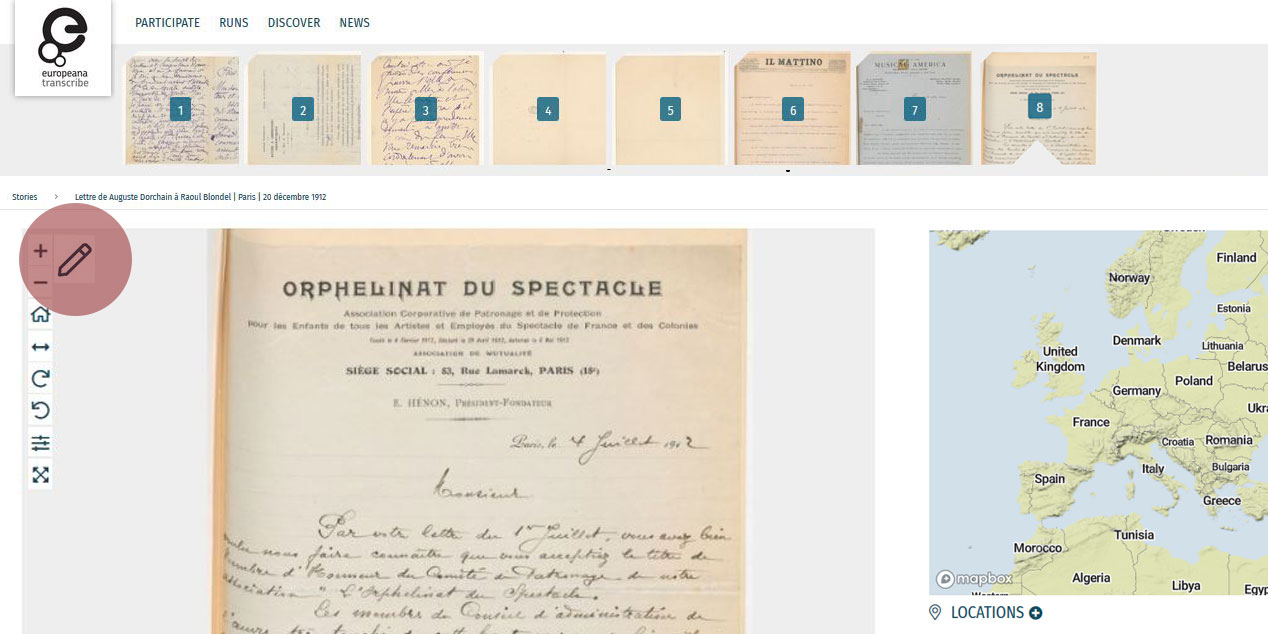
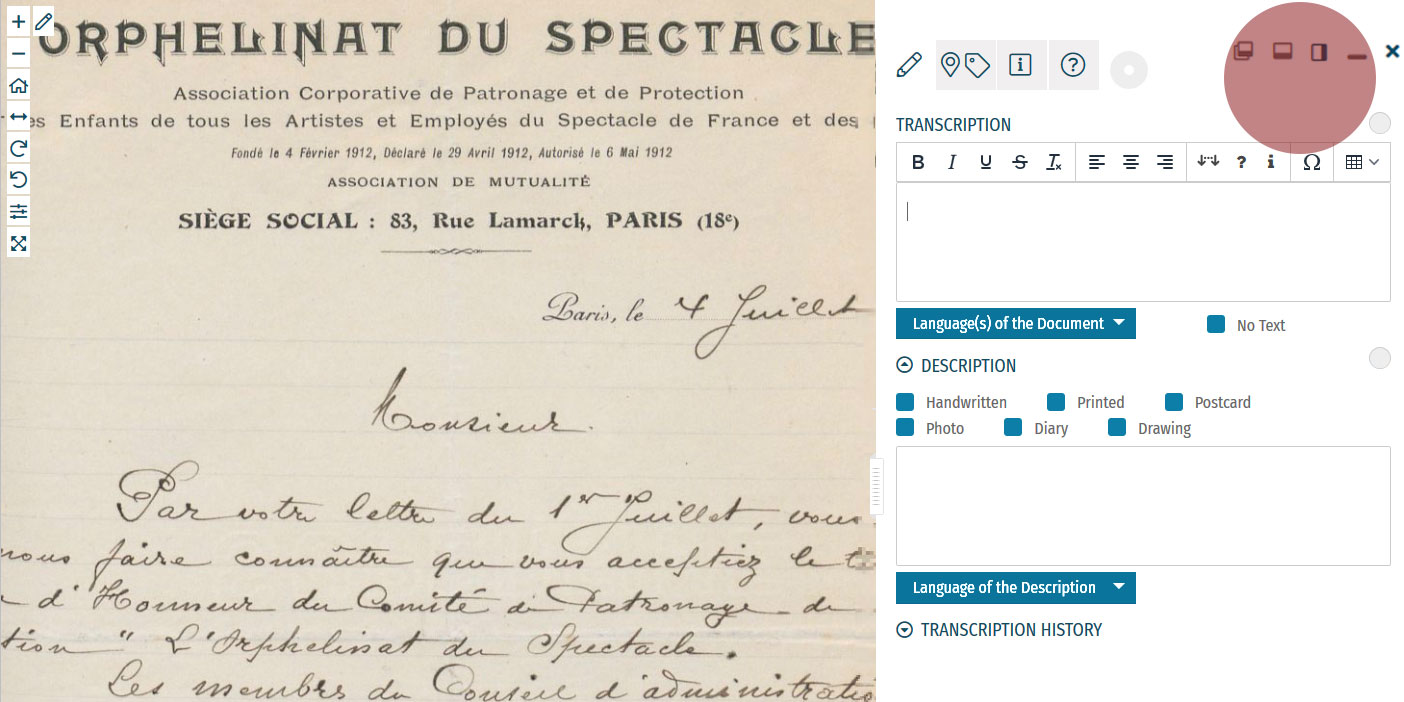
Enrichment Mode
Edit your workspace view by using the top-right menu.
You can have the white Activity Panel docked to the right (default) , to the bottom , or as an independent overlay . If you just want to view the image, you can hide the panel using the minimise button , and then re-open it with the pen button. Adjust the size and position of your Activity Panel according to your preferences.
You enrich documents by following a step-by-step process.
Make sure you regularly save your enrichments in each step to avoid the risk of losing your work.
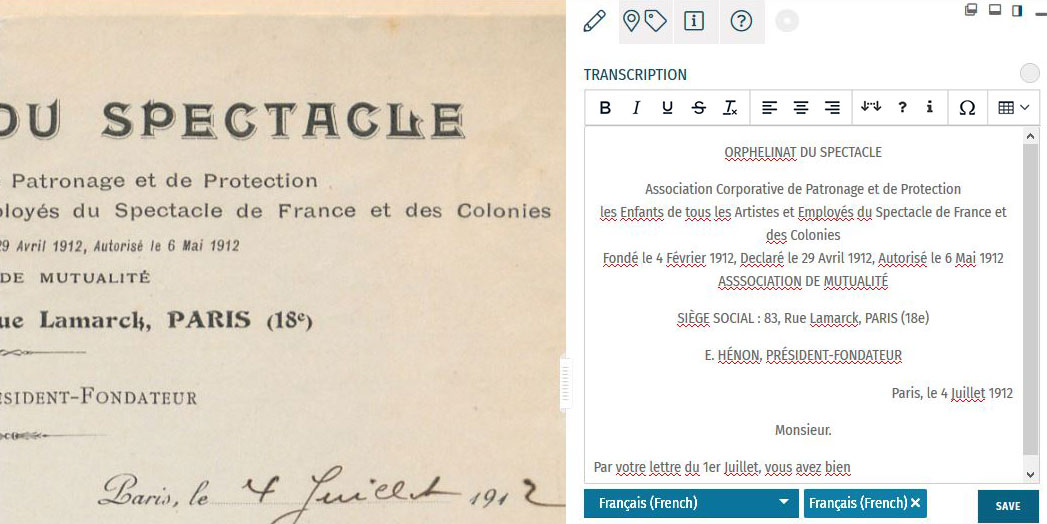
Step 1: Transcription
To start a transcription, select the transcription tab at the top menu of the Activity Panel. Click inside the box underneath the heading TRANSCRIPTION and start writing your transcription. When needed, use the toolbar to format your text and to add special characters and tables. A guide to the transcription toolbar is available in the Formatting section of this tutorial.
Identify the language(s) of the text using the dropdown list under the transcription box. You can select multiple languages at once.
If the item has no text to transcribe, tick the checkbox ‘No Text’.
Once you have finished your transcription, click SAVE.
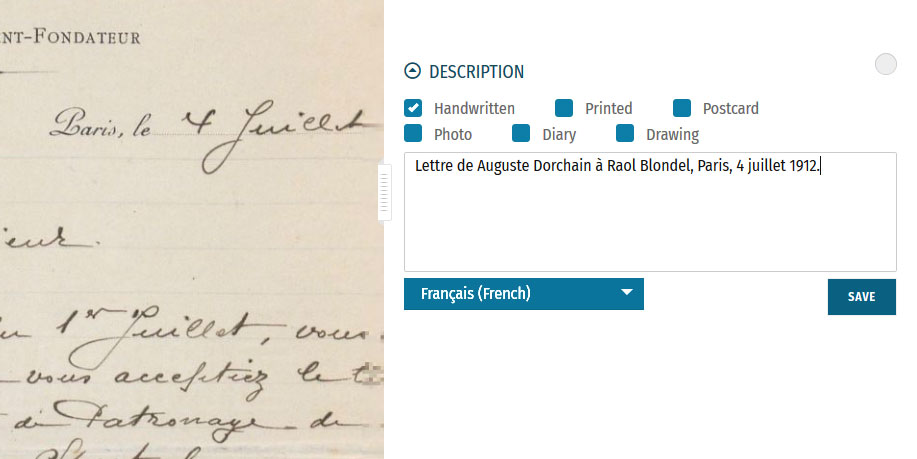
Step 2: Description
You can add a description to the item underneath the Transcription section.
The first task is to identify what type of document the item is: a handwritten or printed document, a postcard, photo, drawing and/or part of a diary. Tick the category which best applies to the item. Multiple categories can be selected at once.
The second task is to write a description of the contents. Click inside the box underneath the heading DESCRIPTION. Here, you can write what the item is, what it is about, and specify the images and objects that appear in the item.
Identify the language of the description text that you wrote using the dropdown list underneath. You can only select one language.
Once you have finished your description, click SAVE.
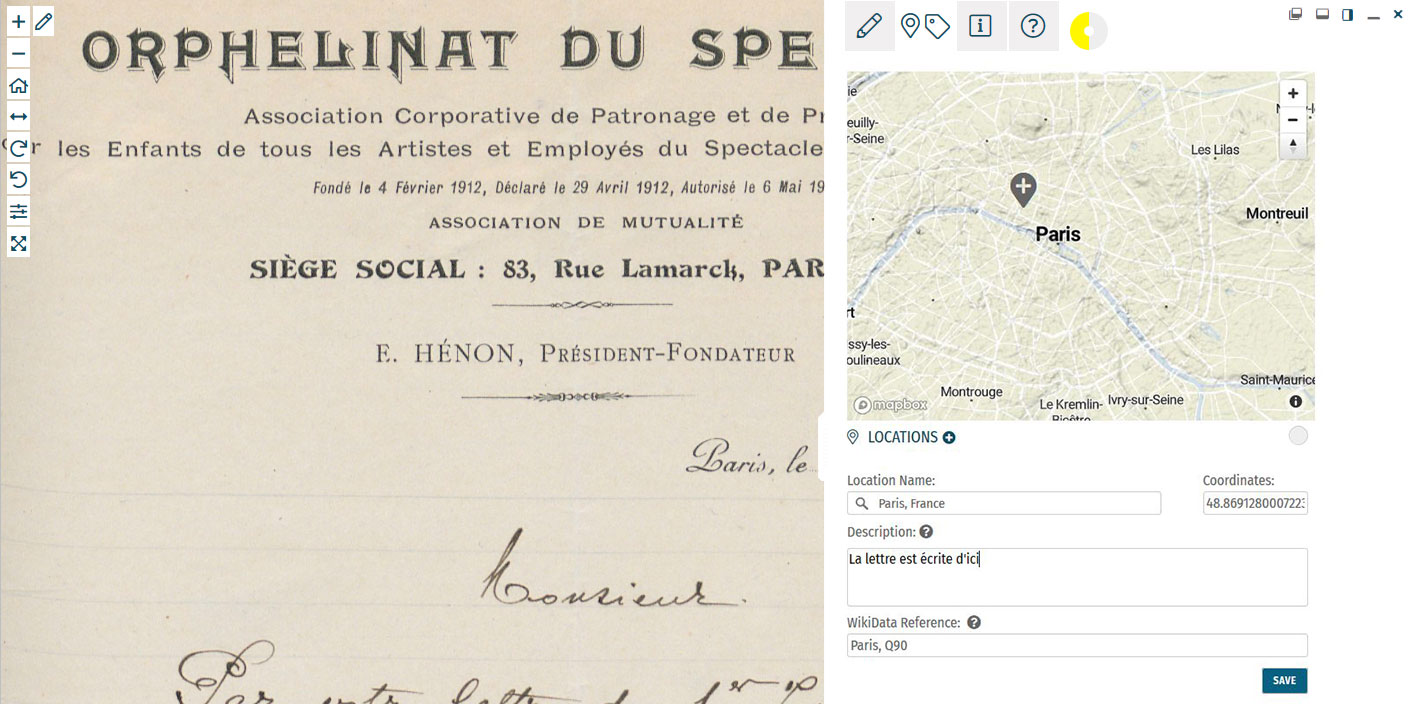
Step 3: Location
If you find a location mentioned or recognise a place in the item, you can create a geotag and pin it to the item map. Multiple locations can be attached to the item. To tag locations, select the tagging tab at the top menu of the Activity Panel. Click the plus next to the heading LOCATIONS. Type the location into the search bar and select the result that best applies. A new pin will be placed into the map. The location name should be a clear georeference, e.g. a country, city or address. Make adjustments to the location name if necessary. You can also adjust the position of the pin by dragging it on the map. If you want to add further details to the location, you can write a (short) description. This could include extra information about the geotag (e.g. the building name or a significant event that took place at the location) or the relevance of the place to the item (e.g. the hometown of the author). You can also add a Wikidata reference to link the location to a stable source. Search for the reference using the Wikidata fields. Once you have finished your location tag, click SAVE. You can find the place(s) tagged to the item in grey at the bottom of the Location(s) section.Step 4: Tagging
Below the Locations section is the Tagging section, where you can add the following annotations:
 Document Date:
Document Date:Here, you can add dates that correspond to the item. This could include the dates mentioned in the text (e.g. in diary pages), the date of a related historical event (e.g. the end of WWI), or when the item was created (e.g. from a dated signature on an illustration). You can either define this as a single date or as a longer time frame.
To tag dates to the item, write the start and end dates in DD/MM/YYYY format in the fields or select the dates by clicking on the calendar.
If you only have one date to add, insert the same date into both start and end fields.
If you don’t know the exact days, you can also tag the date on the scale of months (MM/YYYY) or years (YYYY).
Once you have finished your date tag, click SAVE DATE.
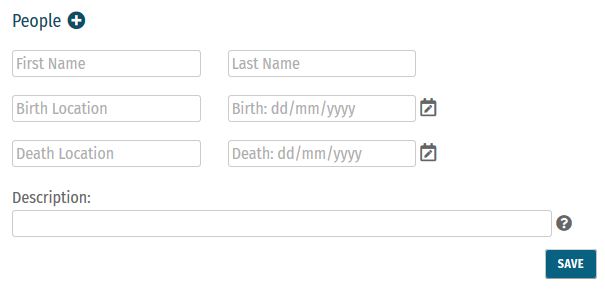 People:
People:People mentioned as creators or subjects in the item can also be tagged. Depending on the information you might have, you can enter the person’s first and last names, as well as their dates of birth and death. There is also the option to write a short description of the person, explaining who they are or their relevance to the item, e.g. the person’s occupation or their relation to another tagged person.
Multiple people can be tagged to one item.
Once you have finished your person tag, click SAVE.
 Keywords:
Keywords:Here, you can freely add keywords related to the topic and content of the item. This could include particular themes (e.g. art, music, war), subjects (e.g. children, cooking, France), or particular historical affiliations (e.g. 20th century, Austro-Hungarian Empire, Fall of the Iron Curtain).
Multiple keywords can be added and they can be written in any language.
Write your keyword tag into the field and click SAVE.
 Other Sources:
Other Sources:External websites with information about the item’s content can be linked here. This could include links to further data about a person mentioned, a particular historical event or links to digital versions of newspapers that appear in photos or clippings in a notebook.
To add a link, click the plus next to the heading ‘Other Sources’. Enter the URL into the Link field, and write a short description of this link in the Additional Description field.
Multiple links can be tagged to one item.
Once you have finished your tag, click SAVE.
Step 5: Mark for Review
Once you have saved your contribution, the task will automatically change to the Edit status. If you think the task is finished, you can mark it for review. Note that you have to be at Runner level or above to do this (see: Miles and Levels). Click on the yellow circle next to the section heading and select Review in the list that appears. The task now needs to go under Review by another volunteer.Formatting
Review
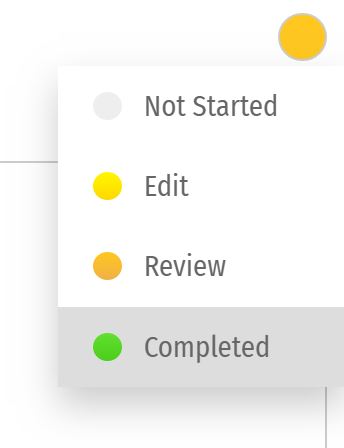 All enrichments need to be edited and reviewed by more than one volunteer to ensure that they are as accurate as possible.
Only Sprinters and Champions can edit tasks in the Review stage and mark them as Complete. (see: Miles and Levels)
You can review a task (Transcription, Description, Locations, or Tagging) when the circle next to the heading is coloured orange .
During the review process, pay close attention to the following requirements:
All enrichments need to be edited and reviewed by more than one volunteer to ensure that they are as accurate as possible.
Only Sprinters and Champions can edit tasks in the Review stage and mark them as Complete. (see: Miles and Levels)
You can review a task (Transcription, Description, Locations, or Tagging) when the circle next to the heading is coloured orange .
During the review process, pay close attention to the following requirements:
-
- Transcription: The complete text in the item has been properly transcribed and the transcription is formatted as accurately as possible. The correct language(s) are selected and the transcription contains no missing or unclear icons.
-
- Description: The description is accurate and detailed (especially items without text to transcribe, e.g. photos), and the appropriate categories have been ticked.
-
- Location(s): All locations have been correctly tagged. The location name is accurate and matches the coordinates and the pin on the map. The description is clear and concise, and the Wikidata reference (if any) is correct.
-
- Tagging: Document dates are completed and as precise as possible. All mentioned people are tagged and their data is correct. All added keywords are applicable to the item, and other sources have accurate information and functioning links.
Completion Statuses
| GREY |
| 1. NOT STARTED |
| Tasks have not been started. |
| YELLOW |
| 2. EDIT MODE |
| Tasks have been started, but not yet finished. Additions and edits can still be made. |
| ORANGE |
| 3. REVIEW |
| Tasks are finished, but need final review by Sprinter or Champion transcribers. |
| GREEN |
| 4. COMPLETED |
| Tasks have been fully completed and reviewed. No further changes need to be made. |
Miles and Levels
Transcribathon is a competitive marathon. You do not enrich documents alone, but compete and work with other volunteers to ensure the quality of your work. When you first create a Transcribathon account, you only have the ability to start and edit tasks. The more you enrich documents, the closer you become to advancing to a higher level, which can unlock abilities like reviewing and completing tasks.| Level | Abilities |
|---|---|
| Trainee | Basic abilities: start and edit tasks |
| Runner | Basic abilities, mark finished tasks for review |
| Sprinter | All Runner abilities, mark reviewed annotations as completed |
| Champion | All Sprinter abilities, mark reviewed transcriptions as completed |
| Tasks | Miles Received |
|---|---|
| Transcription | 1 Mile for every 300 characters transcribed |
| Description | 1 Mile for every 5 Descriptions added |
| Location | 1 Mile for every 5 Locations added |
| Tagging | 1 Mile for every 5 Tags added |
| Reviewing | 1 Mile for every 10 items marked as complete |
